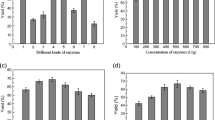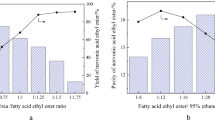Abstract
The separation and purification of linoleic acid (LA) from sunflower seed oil by urea complex fractionation was studied. Crystallization reaction conditions of urea inclusion were optimized using the response surface method, and the optimal model was developed. Using the linear weighting method of the fitting model for optimization, the optimal balance between the purity and the recovery of LA was obtained. Under optimal conditions, the purity of LA was 87.8%, and the recovery was 83.4% at a urea-to-fatty acids ratio (w/w) of 0.94, 95% ethanol-to-urea (v/w) of 5.00, a crystallization temperature of 18.0 °C, and a crystallization time of 5.0 h. Verification results revealed that the predicted values from these models were reasonably close to the experimentally observed values.


Similar content being viewed by others
References
Kinsella JE (1986) Food components with potential therapeutic benefits: the n-3 polyunsaturated fatty acids of fish oils. Food Technol 40:89–97
Simopoulos AP (1997) Essential fatty acids in health and chronic disease. Food Rev Int 13:623–631
Gurr M (1995) A trans fatty acid that is good to eat? Conjugated linoleic acid. Lipids Technol 11:133–135
Ha YL, Grimm NK, Pariza MW (1987) Anticarcinogens from fried ground beef heat-altered derivatives of linoleic acid. Carcinogenesis 8:1881–1887
Hopkins CY, Chisholm MJ (1968) A survey of the conjugated fatty acids of seed oils. J Am Oil Chem Soc 45:176–182
Iverson JL, Weik RW (1967) Correlation of fatty acid structure with preferential order of urea complex formation. J Assoc Off Anal Chem 50:1111–1118
Strocchi A, Bonaga G (1975) Correlation between urea inclusion compounds and conformational structure of unsaturated C-18 fatty acid methyl esters. Chem Phys Lipids 15:87–94
Anonymous (1986) Fish oil production and potential in Atlantic Canada. Project report no. 115. Fisheries Development Branch, Halifax, NS
Wanasundara UN (1996) Marine oils: Stabilization, structural characterization and omega-3 fatty acid concentration. Ph.D. Thesis, Memorial University of Newfoundland, Canada
Hayes DG (2006) Effect of temperature programming on the performance of urea inclusion compound-based free fatty acid fractionation. J Am Oil Chem Soc 83:253–259
Thompson DR (1982) Production optimization. J Food Proc Preserv 6:1–13
Hunter JS (1959) Determination of optimum operating conditions by experimental methods. Ind Qual Control 158:6–11
Lee CC, Hoseney RC (1982) Optimization of the fat-emulsifier system and the gum-egg white-water system for a laboratory-scale single stage cake mix. Cereal Chem 59:392–396
Shieh CJ, Akoh CC, Koehler PE (1995) Four-factor response surface optimization of the enzymatic modification of triolein to structured lipids. J Am Oil Chem Soc 72:619–623
Wanasundara PKJPD, Shahidi F (1996) Optimization of hexametaphosphate-assisted extraction of flaxseed proteins using response surface methodology. Food Chem 61:604–607
Jiang ST, Shao P, Pan LJ, Zhao YY (2006) Molecular distillation for recovering tocopherol and fatty acid methyl esters from rapeseed oil deodorizer distillate. Biosys Eng 93:383–391
AOCS (1998) Official methods and recommended practices of American Oil Chemists’ Society, 5th edn. American Oil Chemists’ Society, Champaign
Box GEP (1954) The exploration and exploitation of response surfaces, some general considerations and examples. Biometrics 10:16–60
Cornell JA (1992) How to apply response surface methodology. ASQC basic reference in quality control. ASQC, Milwaukee
Wu M, Ding H et al (2007) Separation and Purification of linoleic acid from sunflower oil by urea complexation. ICSST
Hayes DG, Bengtsson YC, Van Alstine JM, Setterwall FN (1998) Urea complexation for the rapid, ecologically responsible fractionation of fatty acid from seed oil. J Am Oil Chem Soc 75:1403–1409
Ratnayake WMN, Olsson B, Matthews D, Ackman RG (1988) Preparation of omega-3 PUFA concentrates from fish oils via urea complexation. Fat Sic Technol 90:381–386
Wanasundara NU, Shahidi F (1999) Concentration of omega 3-polyunsaturated fatty acids of seal blubber oil by urea complexation: optimization of reaction conditions. Food Chem 65:41–49
Mason RL, Gunst RF, Hess JL (1989) Statistical design and analysis of experiments with applications to engineering and science. Wiley, New York
Xie KX, Han J, Lin YL (2004) Optimize methodology, 2nd edn. Tianjin university press, Tianjin, pp 208–241
Acknowledgments
Financial support from the government of Tianjin, People’s Republic of China (no. 07JCZDJC02600), is gratefully acknowledged. Thanks also given to J. J. Zeng for his valuable suggestions and Dr. X. Han for his comments on this manuscript.
Author information
Authors and Affiliations
Corresponding author
About this article
Cite this article
Wu, M., Ding, H., Wang, S. et al. Optimizing Conditions for the Purification of Linoleic Acid from Sunflower Oil by Urea Complex Fractionation. J Am Oil Chem Soc 85, 677–684 (2008). https://doi.org/10.1007/s11746-008-1245-7
Received:
Revised:
Accepted:
Published:
Issue Date:
DOI: https://doi.org/10.1007/s11746-008-1245-7




